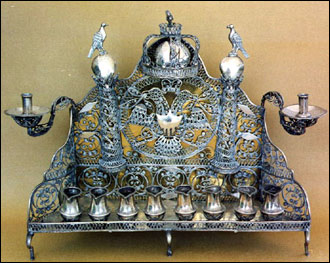
Ukraine, c1825
Silver, gilt silver, filigree, repousse, chased
H 24.5 cm, W 28.1 cm, D 1.9 cm
More than any other style of Hanukkah menorah, this form represents Galicia and the Ukraine. In the literature it is called the baal shem tov lamp, but this name dates only from 1928 when a gift to the then Bezalel Museum was reported as having belonged to the great Hasidic master known by that name. All of these lamps date from far after his death, but the legendary name has remained for the last 70 years, and is widely used today as well.
This particularly aesthetic lamp was first made in Galicia, apparently starting in the 1820s. With the development of the Jewish silver crafts in Zhitomer in the 1850s, these lamps were then produced there, often marked. There are a few example produced in England at the end of the century, probably by immigrant silversmiths from the Ukraine.
From all places they
usually appear with the symbol of the double-headed eagle, as in this
example, or with the holy ark with two doors. Birds, lions and griffins
are often depicted. The large number of examples remaining would indicate
that the use of this type was quite widespread. Examples have appeared
at auction quite regularly over the last decade.